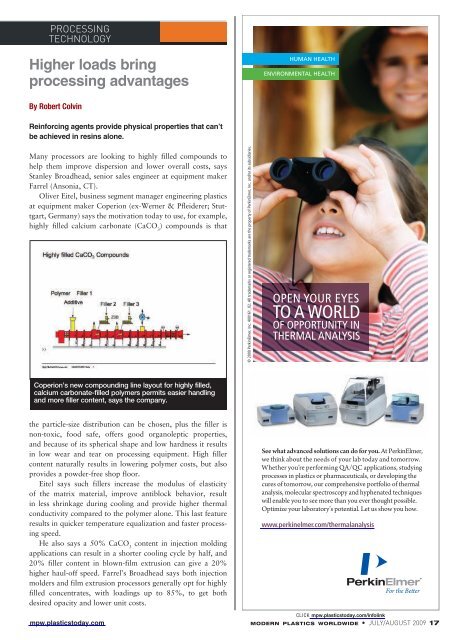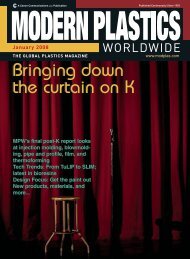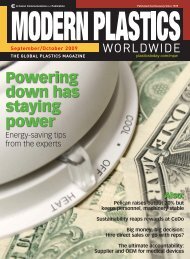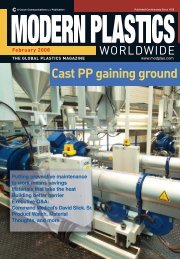Modern Plastics Worldwide - July/August 2009 - dae uptlax
Modern Plastics Worldwide - July/August 2009 - dae uptlax
Modern Plastics Worldwide - July/August 2009 - dae uptlax
Create successful ePaper yourself
Turn your PDF publications into a flip-book with our unique Google optimized e-Paper software.
PROCESSING<br />
TECHNOLOGY<br />
Higher loads bring<br />
processing advantages<br />
By Robert Colvin<br />
Reinforcing agents provide physical properties that can’t<br />
be achieved in resins alone.<br />
Many processors are looking to highly filled compounds to<br />
help them improve dispersion and lower overall costs, says<br />
Stanley Broadhead, senior sales engineer at equipment maker<br />
Farrel (Ansonia, CT).<br />
Oliver Eitel, business segment manager engineering plastics<br />
at equipment maker Coperion (ex-Werner & Pfleiderer; Stuttgart,<br />
Germany) says the motivation today to use, for example,<br />
highly filled calcium carbonate (CaCO 3 ) compounds is that<br />
Coperion’s new compounding line layout for highly filled,<br />
calcium carbonate-filled polymers permits easier handling<br />
and more filler content, says the company.<br />
the particle-size distribution can be chosen, plus the filler is<br />
non-toxic, food safe, offers good organoleptic properties,<br />
and because of its spherical shape and low hardness it results<br />
in low wear and tear on processing equipment. High filler<br />
content naturally results in lowering polymer costs, but also<br />
provides a powder-free shop floor.<br />
Eitel says such fillers increase the modulus of elasticity<br />
of the matrix material, improve antiblock behavior, result<br />
in less shrinkage during cooling and provide higher thermal<br />
conductivity compared to the polymer alone. This last feature<br />
results in quicker temperature equalization and faster processing<br />
speed.<br />
He also says a 50% CaCO 3 content in injection molding<br />
applications can result in a shorter cooling cycle by half, and<br />
20% filler content in blown-film extrusion can give a 20%<br />
higher haul-off speed. Farrel’s Broadhead says both injection<br />
molders and film extrusion processors generally opt for highly<br />
filled concentrates, with loadings up to 85%, to get both<br />
desired opacity and lower unit costs.<br />
mpw.plasticstoday.com<br />
© <strong>2009</strong> PerkinElmer, Inc. 400161_02. All trademarks or registered trademarks are the property of PerkinElmer, Inc. and/or its subsidiaries.<br />
OPEN YOUR EYES<br />
TO A WORLD<br />
OF OPPORTUNITY IN<br />
THERMAL ANALYSIS<br />
See what advanced solutions can do for you. At PerkinElmer,<br />
we think about the needs of your lab today and tomorrow.<br />
Whether you’re performing QA/QC applications, studying<br />
processes in plastics or pharmaceuticals, or developing the<br />
cures of tomorrow, our comprehensive portfolio of thermal<br />
analysis, molecular spectroscopy and hyphenated techniques<br />
will enable you to see more than you ever thought possible.<br />
Optimize your laboratory’s potential. Let us show you how.<br />
www.perkinelmer.com/thermalanalysis<br />
CLICK mpw.plasticstoday.com/infolink<br />
MODERN PLASTICS WORLDWIDE • JULY/AUGUST <strong>2009</strong> 17









